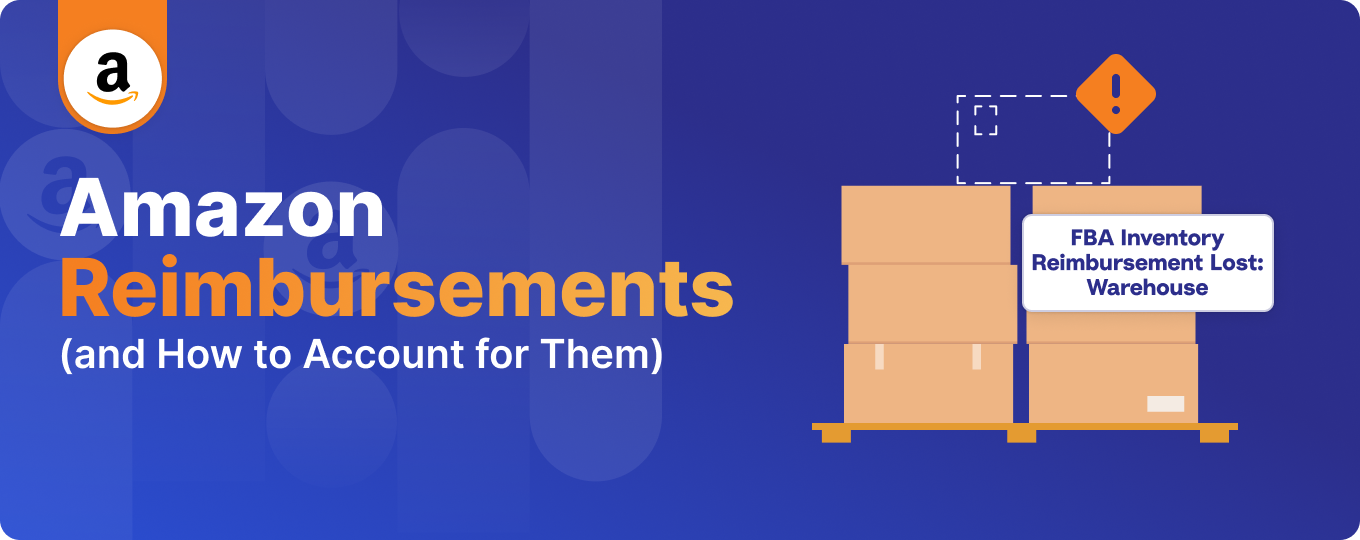Amazon Reimbursements (and How to Account for Them)
Written by: Elspeth Cordray

Updated February 28, 2025.
For many Amazon sellers, handling reimbursements is common practice and part of the day-to-day management of their Amazon store.
Correctly accounting for reimbursements, however, can be complex – and is critical to get right.
Reimbursements must be categorized properly to reflect your business’s true financial position. For example, a reimbursement for a lost shipment should be recorded as a recovery of lost income, not as a sale. It’s also important to accurately track reimbursements to ensure you’re treating these amounts correctly from a tax perspective.
This guide is part of our series about how to account for the many different types of Amazon transactions correctly. Read on to learn more about why it’s so important for Amazon sellers to accurately account for reimbursements, and how to do so with A2X.
Key takeaways:
- What are Amazon reimbursements? Amazon reimburses sellers for various reasons, such as lost or damaged inventory, customer returns, or other fulfillment-related issues. While Amazon’s reimbursement process is often automatic, sellers should actively monitor their transactions to ensure they receive all the funds they are owed.
- Reimbursements should be recorded separately from sales to avoid inflating revenue and misrepresenting financial performance. Additionally, since reimbursements typically do not include sales tax or VAT, proper tax treatment is crucial. Consulting a tax professional can help ensure compliance and prevent potential tax issues.
- Manually tracking and categorizing reimbursements can be complex and time-consuming. Using automation tools like A2X simplifies the process by accurately mapping transactions to the correct accounts, ensuring financial clarity, and reducing reconciliation errors.
What are Amazon reimbursements?
Amazon reimbursements are payments made by Amazon to its sellers for various reasons. Some of these reasons could include:
- Damaged or lost inventory: If inventory is damaged in Amazon’s fulfillment centers or lost during shipping by Amazon, sellers are eligible for reimbursement.
- Customer returns: Sellers may receive reimbursements for issues related to customer returns, such as if a customer is refunded but doesn’t return the item, or if the returned item is damaged.
The Amazon reimbursement process is typically automatic. Amazon periodically reviews transactions and inventory to identify cases where sellers are owed money.
However, it’s also crucial for sellers to actively monitor their accounts and transactions, as not all cases might be automatically detected by Amazon.
Sellers should regularly check their inventory reports and transaction records. If discrepancies are found, sellers can file a claim with Amazon for investigation and potential reimbursement. Just keep in mind that Amazon typically imposes a time limit for filing reimbursement claims.
You can review reimbursement transactions in Amazon Seller Central:
- Navigate to ‘Reports’
- Click ‘Payments’
- Select the ‘Transaction View’ tab
- Sort by ‘Transaction Type’ – reimbursements can usually be found under the ‘Other’ transaction type
Amazon also has an article about reimbursements which you can find here.
What Amazon reimbursement transactions look like (examples)
Amazon reimbursement transactions can show up under a few line items in your Amazon seller statement, including:
FBA Inventory Reimbursement Customer Return | Reimbursement for a damaged item for which Amazon has taken possession |
Other Transaction FBA Inventory Reimbursement Damaged: Warehouse | Compensation for warehouse-damaged inventory |
FBA Inventory Reimbursement Lost: Inbound | Reimbursement for inventory lost or damaged during shipment |
FBA Inventory Reimbursement Lost: Warehouse | Payment for inventory lost in warehouse |
Other Transaction FBA Inventory Reimbursement (sometimes appears as: “REVERSAL_REIMBURSEMENT”) | When Amazon takes back the cash payment for a previous reimbursement and gives you inventory instead |
Other Transaction FBA Inventory Reimbursement (sometimes appears as: “WAREHOUSE_DAMAGE”) | A reimbursement if an item you send to the Amazon warehouse gets damaged |
You can use A2X to easily keep track of and correctly categorize Amazon reimbursements, and all other Amazon fees and transactions. Keep reading to learn more.
Why does accurate accounting for Amazon reimbursements matter?
Sellers should be able to easily identify and keep track of Amazon reimbursement amounts to a) ensure you are receiving all the funds you’re entitled to, and b) maintain accurate financial records and tax compliance.
There are a couple of common mistakes that sellers make when accounting for reimbursements that can have a major impact on their Amazon accounting accuracy (which can then cause even larger business issues).
Mistake #1: Categorizing reimbursement amounts as “sales”
The first mistake that sellers often make when accounting for reimbursements is categorizing reimbursement amounts as “sales”.
It’s important for sellers’ financial records to show that:
- Sales represent the revenue generated from the actual business operations – the selling of goods or services to customers. It is a core financial metric indicating the primary business activity.
- Reimbursements are compensations for specific issues like lost, damaged, or returned products. They are not generated from the seller’s typical business activities but are rather corrections or compensations for problems or errors. As such, they are considered “other revenue” and should be recorded separately from product sales revenue.
Miscategorizing reimbursements as “sales” can inflate the actual sales revenue that your business is generating, which gives a misleading picture of the business’s performance.
Mistake #2: Incorrect tax treatment for reimbursement amounts
The second common mistake that sellers make when accounting for reimbursements is incorrect tax treatment.
Often, Amazon reimbursements are paid to the seller without sales tax or VAT. Given each Amazon store’s unique situation – e.g., tax jurisdiction(s), reimbursements for inventory you might have claimed as expenses for tax purposes, etc. – proper tax treatment for reimbursement amounts requires careful consideration.
A2X does not provide tax advice. We strongly recommend consulting with a local tax advisor to ensure that you’re correctly managing tax for all of your Amazon transactions, including reimbursements. ( Find an ecommerce accountant on the A2X Directory!)
Accounting for Amazon reimbursements using A2X
The good news: Using tools like A2X can help you properly account for reimbursements and all other Amazon transactions so you can keep accurate financial records and apply proper tax treatment.
Here’s how it works:
To get started, all you need is your Amazon Seller Central login and your accounting software login (e.g., QuickBooks Online or Xero).
1. Set up A2X
Connect A2X to your accounting software. Then, connect A2X to your Amazon store.
2. Map your transactions to your Chart of Accounts
Once connected to your Amazon store and your accounting software, A2X will pull in your recent Amazon settlements.
Now, it’s time to “map” the different transaction types to the corresponding account in your accounting software and assign tax rates, if applicable.
Go to the ‘Accounts and Taxes’ page to set this up. We recommend following the prompts to answer the questionnaire and use A2X’s default setup to save time. (You can always adjust your mappings after the default setup is completed, if needed.)
The chart below details how A2X will automatically map Amazon reimbursement transactions. We recommend assigning reimbursements to a specific reimbursement account so that you can clearly distinguish reimbursement amounts in your P&L.
Important: Given how critical it is to ensure correct tax treatment for reimbursements, we strongly recommend working with an advisor to decide on a tax rate to be applied to Amazon reimbursements. Once you decide and assign a tax rate, A2X will automatically apply this tax rate to all Amazon reimbursement transactions moving forward.
Amazon Transaction | A2X Default Account | Account Type |
FBA Inventory Reimbursement Customer Return | Amazon Reimbursement | Income |
Other Transaction FBA Inventory Reimbursement Damaged: Warehouse | Amazon Reimbursement | Income |
FBA Inventory Reimbursement Lost: Inbound | Amazon Reimbursement | Income |
FBA Inventory Reimbursement Lost: Warehouse | Amazon Reimbursement | Income |
Other Transaction FBA Inventory Reimbursement (sometimes appears as: “REVERSAL_REIMBURSEMENT”) | Amazon Reimbursement | Income |
Other Transaction FBA Inventory Reimbursement (sometimes appears as: “WAREHOUSE_DAMAGE”) | Amazon Reimbursement | Income |
If you sell on multiple marketplaces in different countries, you might also see a country or marketplace breakdown of your data.
3. Review and post
After you’ve mapped your Amazon transactions and worked with an advisor to apply the correct tax rate, go to the ‘Settlements’ tab in A2X.
Here, you’ll see a list of your recent Amazon settlements. Click on ‘Review’ to check to see how A2X has categorized the transactions that make up each settlement.
If everything looks correct, click ‘Send to [Your Accounting Software]’ to send the settlement data to your general ledger.
4. Reconcile
In your accounting software, look for the settlement you just sent from A2X in the bank feed. The amounts should match, and you should be all set to reconcile!
5. Keep up with your bookkeeping
Accurate and timely bookkeeping is best practice when running an Amazon store. Get in the habit of sending Amazon settlements from A2X to your accounting software every time they come through so you can keep your accounts up-to-date and reconciled.
Better yet – use A2X’s Auto-Posting feature to automatically send settlements from A2X to your accounting software and save even more time.
Reimbursements in your P&L
By using A2X’s mapping feature and setting up a dedicated Amazon Reimbursement income account, you unlock the clarity of seeing reimbursement amounts as a distinct line item on your Profit and Loss statement (P&L).
This approach can provide valuable insights into your business’s health and operations. First, it keeps your actual sales figures separate – no more mixing sales numbers with reimbursements, which can give a misleading picture of your performance. Plus, it streamlines the process for any unique tax handling that reimbursement amounts might need.
By monitoring your reimbursements through accurate accounting, you’ll also start to paint a picture of your inventory’s journey, noting how often items are lost or returned. This is more than just numbers; it’s a window into your business’s health and efficiency, offering you the insights you need to fine-tune your operations.
Accurate accounting can make your business better
Proper Amazon accounting and bookkeeping is not just about keeping your books in order – it’s about gaining data and information that can help you reach your business goals.
Get accurate and automated accounting for all of your Amazon transactions with A2X. Sign up for a free trial today!
Learn more about Amazon seller fees and transactions and how to account for them:
- Amazon Order Revenue Transactions (and How to Account for Them)
- Amazon Delivery and Transport Fees (and How to Account for Them)
- Amazon Commission and Selling Fees (and How to Account for Them)
- Amazon Fulfillment and Storage Fees (and How to Account for Them)
- Amazon Subscription Fees (and How to Account for Them)
- Amazon Reserve Balances (and How to Account for Them)

Integrate Amazon and your accounting software for accurate accounting
A2X auto-categorizes your Amazon sales, fees, taxes, and more into accurate summaries that make reconciliation in your general ledger a breeze.
Try A2X today
